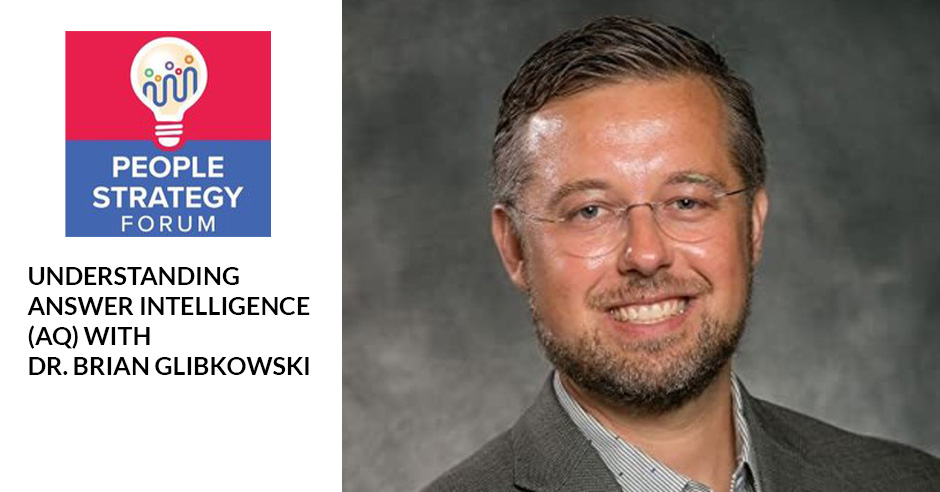Understanding Answer Intelligence (AQ) With Dr. Brian Glibkowski

Business meetings are often spent on asking questions but not coming up with the right answers, leading to an endless spiral of problems and wasted time. Dr. Brian Glibkowski aims to address this through a concept he calls Answer Intelligence. Joining the People Strategy Forum hosts, he breaks down how AQ can give you greater influence, start intentional conversations, and improve a team’s brainstorming process. Brian also presents the software they have developed that goes along with the AQ philosophy, combining communication and technology into one efficient tool.
—
Understanding Answer Intelligence (AQ) With Dr. Brian Glibkowski
I’d like to introduce to you our hosts. My myself is Sam Reeve. I’m a reward strategist. I specialize in compensation. I’m here with Char Miller who is a people strategist. She is a former CHRO of some large healthcare organizations and she loves to do her own thing. She has several businesses that she runs. It’s a pleasure to have her here. She’s quite a small business expert on those things.
It’s also a pleasure to introduce our guest. We’re thrilled to have Dr. Brian Glibkowski. He is a Founder of Answer Intelligence. He is not just a celebrated author but he’s also a researcher. He’s a visionary in understanding the profound impact, questions, and answers that we use in communication. We’re going to be talking a lot about that.
His concept is brilliantly captured in his book Answer Intelligence: Raise Your AQ. His insights extend beyond academia into practical applications. His research is being adopted by many prestigious institutions across the globe. I’m looking forward to hearing more about that. Let’s welcome Dr. Brian Glibkowski. How are you doing, Doc?
I’m doing well. Thank you, Sam and Char. I’m excited to be with both of you. Thank you for having me.
Before we get started, I know that you have your book Answer Intelligence. We’d love to hear a little bit more about that and the app that comes with that. Before we get there, can we hear a little bit about your experience? How did you get to where you are now in helping the people that you help?
My background has been in and out of academia as a management professor. I researched questions and published that in academia. When I was doing this research, one super obvious thing that we knew a lot about was questions. If you think about it, going back to grade school, we learn about the six WH questions and open and close questions.
Sales and coaching methodologies are based on questions. It hit me that we do not have the same level of understanding or focus on the answer side of the equation. Case in point, I mentioned those typologies of answers, six WH, open and closed. Outside of my research, there are no typologies of answers. If I asked how many answer types there are, I’d get a blank stare.
That stimulated my interest. I conducted research with the top instructors in the world. I came up with an Answer Intelligence framework. It’s a six-answer type that maps the questions, concepts, metaphors, theories, stories, procedures, and actions. I wrote a book, did a TEDx, and went to the market. We have partners in nineteen countries around the world that use Answer Intelligence with their clients. That’s my background and where I’m at in a nutshell.
Let’s start with the first basic thing that some of our audience may have on their minds on the six WH questions. Can you go through those to refresh us?
It’s why, what, how, when, where, and who. Those are the six. Those are the questions we use, and there are answer types that map to those different questions.
Can we dig into that a little bit? Can you briefly explain the concept of Answer Intelligence and its fundamental principles?
Let me explain what AQ is and give you one example. Answer Intelligence is the idea that we can provide elevated answers to important questions. It’s the answer side of the equation where the influence rests primarily. Let’s imagine you’re an emerging leader and you have to ask and answer basic questions about leadership for yourself. What is leadership? Why do I lead? How do I lead? In AQ terms, you connect those questions to answers.
For example, what is leadership? I could answer that by saying, “Leadership is inspiring others and holding them accountable to achieve a goal.” That’s a concept answer type. Second, I could say, “Leadership is like two ropes. When the ropes are separate, they’re strong. When they’re braided together, they’re stronger. That’s how I lead. Every meeting, I’m going to inspire and hold people accountable.” That’s a metaphor answer.
To answer the question “What is leadership?” you can provide a concept and/or a metaphor answer. That’s what AQ is. It is understanding how questions map the answers and identifying the appropriate answers. When you give the appropriate answers, you have greater influence. To punctuate this, imagine that as a leader, I’m meeting with a direct report for the first time. They may explicitly ask me, “Brian, what’s leadership to you?” More likely, it’s going to be implicit. If I can deliver those answers, the concept, and the metaphor, I’m setting expectations. I’m influencing the relationship. That’s an example of what AQ is.

Answer Intelligence: AQ is understanding how questions map to answers. By identifying the appropriate answers to give, you will have greater influence.
A lot of times, when we think about traditional communication, it seems like we’re often thinking about the next question to ask. It seems like you’re flipping that on its side there. You’re saying that we should be thinking about the answers first. Is that correct?
I wouldn’t necessarily say one before the other but I’m saying both are important, and answers have been underappreciated. To explain my view of questions and answers, it’s like a dinner conversation with a friend. For your audience, imagine a recent dinner conversation with a friend, you and one other person. Chances are that conversation has a couple of attributes. One, both sides speak about it equally. Both sides ask and answer questions equally. Both sides care about each other.
That underlines my basic idea for conversations. It’s about balance. It’s about using both sides of the equation. If we’re only thinking about the question side, we’re not focusing on the answer. You have to do both. What does that mean? That means you can still start conversations with questions, but there may be times when you start conversations with answers. You tell an interesting story to a team. It sets the context for other questions and answers.
The overriding message here is both questions and answers are important. We need to do both. Our approach towards communication is frankly simplistic. People don’t understand there are answer types. They don’t know how to map to questions. We want to bring them up to speed and do both, and it’s near to equals.
What does this look like when you’re interacting with your clients? How can the AQ approach be implemented effectively? What does that look like?
I’ll give you two examples. One in sales and one related to a people management issue. In one way or another, we’re all selling things. You’ve heard this expression before. Whether you’re a salesperson or you’re selling your idea to someone else, one simple thing you can do is challenge a sales organization or challenge the idea you want to sell. Can you communicate your solution, product, or service in six answer types? That’s challenging for people. You realize quickly that maybe you have a story, but you don’t have a metaphor. You need all these answers. That’s important.
Let me give you an example related to people management. Let’s say you’re coaching a client and you’re an executive coach. The client is thinking about going back to the office after COVID. In AQ terms, you need to be able to ask and answer basic questions. What does it mean to go back to the office? Why are we going back to the office? How do we go back to the office?
Without AQ, we’re naturally going to provide some of these answers. That executive going back to the office, maybe in an all-hands meeting, may have a story at the ready that’s going to explain why we’re going back. You’ll say, “Remember when we’re all in the office in person. We created this great idea around the conference table. We’re going back to that again.” That’s wonderful. In AQ terms, you have to ask and answer all the questions. You can imagine a scenario where this executive going back to the office might fail to identify a procedure for how they’re going back to the office.
Someone hears a story and they may say, “That’s great, but how are we going to do it?” The executive might lay out a simple three-step procedure, “Month one, we’re doing this. Month two, we’re doing this month. Month three, we’re doing this.” By doing that, what happens? Confidence goes up and overall, we are going back to the office. Without explaining the procedure, what are people going to say? They’re going to say, “Nice story. They’re not serious about this. They haven’t thought through how it’s going to work.”
In this example, AQ is about having intentional conversations. When there’s something important, you want to provide multiple answer types. In an all-hands meeting, people are going to be thinking about implicit and explicit questions, “Why are we going back? How are we going back? What does it mean to go back every day of the week?” Those are two examples. One in sales and one in a coaching context. Your audience could generalize this to other conversations you have. You’re asking and answering basic questions. It connects to the appropriate answer types.
It’s making sure that you have robust answers that are going to address the needs of the people you’re communicating with. Coming up or brainstorming around the answers is one thing. When we’re changing the context and when we’re looking at multiple countries, communicating to different demographics, or using different communication channels, how does AQ evolve when we take those factors into consideration?
For those who are tuning in, I’m sure you’ll be exposed to a visual. Answer Intelligence is a circular framework of six WH types. There are three basic questions. The what question relates to the concept and the metaphor. The why question, theory, strategy, or story. The how question, procedure and action. There’s a mapping. When and where is below the entire circle. It’s saying that every single question and every single answer exists in a context. The answers may change or vary.
For example, if I’m on a job interview and all else being equal, I’ll tell a story. If I’m on a job interview with a bank, else being equal, a story about me working in a bank is better in this situation. If I’m interviewing in a bakery, I’ll tell a story about being in a bakery. Answers are influenced by context. In a way, it elevates things from checkers to chess. There are more things to think about and be aware of. We do all this naturally, but AQ provides you with a framework to map these contextual differences. Let me stop there and see if that response makes sense.
It totally does. When we’re thinking about the context there, I’m wondering about your app. What was the drive to create the app that goes along with your philosophy?
There’s a phone app and a software platform. I’ll talk about the software platform. We developed a software platform. It’s infused with AI. I’ll give you the benefits of this. With the framework, it allows you to be intentional. One thing we’ve discovered is that answers are hard. Imagine someone asks you and you’re an emerging leader. I say, “What is leadership to you? Give me a concept and a metaphor. Why is leadership important? Give me a story, a theory, and cause and effect like when leadership leads to employee retention.” I say, “Give me a procedure of how you’re going to lead a meeting or a performance review. Give me a key action that’s unique and best practice.” What we’ve realized is that answers are hard. To have a brief digression, answers are more difficult than questions. I can come up with questions right now like, what’s the meaning of life? What are you going to be when you grow up? Those are relatively easy to ask. It’s the answers that are always more difficult.
Answers are more difficult than questions. You can easily come up with questions to ask, but giving the right answers is certainly a challenging task. Share on XWhat we found is that there was a gap in that. It exposed these weaknesses. I would love to have these answers. What AI does with our software is it serves up different answer sets, options, and surveys people can take that give you and expose you to answers. To keep it succinct, imagine you’re going through a wizard where you’re developing your own answers for leadership.
When you get to metaphors, the software curves up five metaphors based on different contextual factors that you get to choose from. It accelerates the process of connecting to answers. That’s what the software does. This may sound obvious, but AI has unlimited breadth and depth of knowledge. We’re tapping into that in a structured way through our framework to make sense of it and to better operate in the world.
In a sense, the app is designed for leaders to use to craft their communication. It’s the way for them to ramp up and hone their skills as a leader in their professional development.
With the AQ framework, there are two pieces to understand. AQ is a framework. A framework has principles that you can use to navigate the world. Before I gave the example of leadership, it’s inspiring others, holding them accountable, and the two ropes metaphor. If I gave both utterances at once, that would be high IQ practice too. It’s a technique to answer twice to appeal to the logical and emotional sides of the brain.
You don’t always want to answer twice. If I answered every single question twice, it’d be like a monologue. It wouldn’t be a conversation. What I’m getting at is with AQ, there are principles and techniques of highly effective communication that we’ve learned from experts. One, you have to know that. The second piece is you have to know the content.
It’s not good enough to know you need a metaphor for leadership. You have to know what that leadership metaphor is. Your employee who has been passed over for promotion is not good enough to know that you need to tell them a story. You have to have content. You bring both together. That’s where you have truly impactful communication.

Answer Intelligence: In leadership, it is not good enough to know what you need. You also need to bring people together to come up with impactful communication.
There’s one thing that I’d love to hear from you, Char. When we’re thinking about communication, it comes in a lot of different forms. Preparing the answers is one and there are other things such as body language, how we deliver, and the setting. What was your experience Char in communication in an executive setting?
First of all, I want to say I agree with what Brian is talking about. It is fascinating when you work with AI and it is all about prompting questions. The response takes you down different aspects of the questions of detail. For example, I typed in, “What is talent management strategy?” It came up with what talent management strategy was and all the different buckets, but it started digging in deeper. I found that fascinating of all the aspects of account management.
I’ve been in many staff meetings, management meetings, and all-hands meetings. In the room, it is in silence, maybe 100 employees or 100 leaders. That’s dangerous when no one is responding with an answer or prompting more discussion and dialogue, and the executive is doing all the talking with the talking heads. Unfortunately, I saw a lot of executives doing all-hands meetings or coffee with the CEO. They ended up walking away not learning anything about the real issues that were on the floor.
As an HR professional, I often spent time with the employees at all hours of the day and knew the underneath of what some of the real issues were. I was often disappointed when employees were fearful or felt anxious about being honest and forthright. With that feedback, it can be a problem if the executive or leaders in that room don’t appropriately follow up. It’s like tattletailing on my boss’s attitude. That senior person will go running to that leader of that division or that department and say, “What the heck is going on? What do you mean that we’re having customer service issues here, lack of communication here, or your staff doesn’t have the tools and resources to do their job effectively?”
It needs to be a fully mapped out process with all levels of employees and leadership’s buy-in about what our communication processes are. It goes back to the basics of being authentic and transparent and being able to prepare for those right questions. I know we talk about this all the time, but a leader needs to do their homework. I love your methodology of doing that to walk into that employee meeting with a vision of exactly what information we need to extract from our employees and leaders in this meeting. What is our goal? If that meeting is not effective, we need to come up with a different approach.
I love your hands-on, just-in-time methodology of having an app or something on the database. Often, leaders don’t have the ability to do the homework prior to a meeting. You’re giving them the tools and resources to do that quickly and efficiently. Brian, do you find a lot of leaders resistant to this approach? Do you find leaders understanding that this is vital to be able to have more in-depth communication and find the why’s and the what’s of the answers? What do you think of that acceptance by leaders?
This may not be surprising, but the acceptance is high. I’ll tell you why. There are a lot of frameworks that are out there. You’re a purple cow, you’re a five-star, you’re this and that. I won’t pick exact frameworks. I don’t want to put any framework down. AQ is simple questions and answers. Who is going to doubt those six questions and the answers? We use them. It’s a natural language overlay to any topic.
No one wants to learn a million frameworks. This is simple. There’s acceptance. They like the framework of simplicity. They also realize that they have things to learn. They need to improve. There’s a skill they can improve on. There’s a platform that has answers. People are receptive. Pointing out in terms of things to learn, we have an AI-infused test. Our entire platform is you give it a prompt and say, “My employee is passed over for promotion.”
The AI will serve up a topic. It’ll say motivation. It’ll serve up three question types. Why, what, and how. You simply have to map, given the question type, what answer type you would use, story, metaphor, and theory. We have this tool. On average, the score is slightly below 50% correct. People are not aware of how questions and answers map. Getting to the longer answer and back to the short one, people think it’s valuable. They realize they don’t know how to do it. It’s relatively easy to upskill, and people are receptive. That’s my answer to your question.
Are you using the app as part of a coaching program? Are you interfacing with learning and development organizations that help create programs around the content? What’s the most common approach?
It’s primary go-to-market through professional service firm partners that do coaching, training, and consulting for any topic, but enterprises can pick us as well. They’re using the software in the context of coaching, training, and consulting. One of our partners in Slovakia had a client. It’s a large insurance firm that wanted to use AQ. The first group that was interested was the cybersecurity group.
The partner in Slovakia doesn’t know anything about cybersecurity. I don’t know anything about cybersecurity, but we used the software to generate an answer set of all the different answer-type stories, metaphors, theories, and concepts and had a push button output to twenty PowerPoint slides. We simply put a cover slide on. We said to the cybersecurity firm, “These are the answers you’re going to get in training.”
They were sold because they didn’t have alignment around those answers as an internal service of cybersecurity. We showed them three different definitions of cybersecurity, different metaphors, and dimensions of how you break it down. They disagreed. That was the point. If you don’t have alignment on what something is, why you do it, how you do it, how are you going to be consistent? How are you going to communicate with others? They were sold on that. Going back to how it’s used, there are coaching, consulting, and training applications, depending on what the partners do.
We’ve talked about a lot of things here is the AQ and how it’s used in general communications from a leadership perspective and coaching around the platform. If organizations want to use this to build more cohesive teams, could they use it in that context around individuals who may not be indirectly in leadership?
Yeah. AQ can be focused on any topic. There are things that you do within teams that you could focus on, but even getting your grips on what teamwork is and getting alignment around what we define it as why it’s important or how we do it, you can get into more specific details thereof, but it’s a way to get alignment around any topic.
I could take it out of teams because the content is important right off the top of my head, and it has a great example to give you. Let’s switch it up and say, instead of teams, imagine you want to create mentoring within your company. In AQ terms, you can create alignment around what mentoring is, why you do it, and how you do it, and say you go through this exercise and answers spit out. At the end of the day, you come to alignment and like, “What it is?” You could say, “Mentoring is helping others to become their better future selves at work. It consists of three dimensions, career support, social support, and role modeling.”
We are getting alignment on this. It’s not other things. It’s what this is. You have metaphors to explain it. You can see the natural progression where people are going to start to ask questions like, “How do I do mentoring? How do I do social support? I know what the concept is, but how do I do it?” You go through the software and it starts to spit out different answers.
It might come as an example of a procedure, “Let me tell you about a three-step procedure to provide an open-door policy procedure. Step one, your door is open. Step two, you invite someone in, and you ask them, is this going to take less than five minutes? If so, is it going to take more than five minutes?” You need to schedule another meeting. Step three would be the actual meeting or scheduling something else.
I’m bringing this back to social support. There’s task support and social support. Task support is like, “How do I fill out my TPS report or some project plan.” That’s less emotionally taxing, but social support is emotionally taxing. If I’m having a fight with some other teammate or I feel less confident, the thing with social support is you want to provide it exactly when you need it. That’s why you do the open door policy and meet right when you can.
The picture I’m painting here is you’re creating a multi-dimensional view of what mentoring is, how you do it, and connecting to the appropriate answers. If we’re focused on teamwork, you do a similar exercise and understand the appropriate answers. You begin to have an indwelling in those and use them. It is a transformative thing from having some vague sense of teamwork to having a crystallized sense of teamwork around all the answers connected to the important questions, and then you’re ready to go.
When you’re working with your clients, especially in the past six months or so, have you found that there are any prevailing trends that are particularly important in your line of work?
It’s the importance of communications accelerating and even taking the trend line back a little bit. Going back to when COVID happened, we had virtualization, remote teams, and Zoom. Those all put a premium on communication. Meetings are shorter. We have to be better and more effective. That started the process, and then AI came. It is another interruption from a communication standpoint. There’s this thread out there that AI is going to take your job and it can communicate well. You have to be even better.
We can leverage AI, but it’s putting a further premium on effective communication. We see this accelerating. One trend is the importance of communication is only accelerating. Second, it’s related to virtualization and degree of change. Change is increasing and we have to be better communicators. That’s been accelerating the need for something like AQ because the content of things is changing.
We got product launch one or product launch two. Whatever you’re doing, it’s accelerating. Every time we do a product launch, we have to communicate better. Every time we do a reorg, we have to communicate better. It seems the pace of everything is accelerating. Given any change, you have to be able to communicate better. Those are the two big trends that I wanted to point out that we see in the marketplace.
Everything is accelerating these days. You have to learn how to communicate better to keep up. Share on XYou were talking about AI being a big factor in 2023 and how it’s being introduced to business. It’s been a huge boom in 2023. I know that you’re incorporating this into your tool. How can this help customized communication in the future? As you can imagine, when leaders are brainstorming on their approach, there are some common themes that come up because of the cultural aspect of their organization, people, or country that they’re in. Does your tool over time customize the approach of how it’s answering questions or helping guide the brainstorming process with leaders?
Yes, the way the AI works is you can get content from the general pool of open AI. You can also do specific training related to localized content. We’re focused more on the general AI platform, but we’re starting to do some more localized content. You can make it more specific and useful for you. You have an inventory of hundreds of answers. You can survey this and do things like that. That’s helpful.
The other thing with AI that is particular to our platform, but any platform, one insight was when AI first came on the forefront, I was thinking, “Do we need AQ? We have AI.” AI questions and answers, in a sense, and AQ questions and answers. The reality is what you understand, what you dig into neural networks is, underscoring a point that we all know, that AI is a natural language model. It produces results, but it does it in a way that’s different than the way our brain works. It’s a neural network, but it’s different.
The insight we had with our platform is we’re using AQ to structure input and output from AI with the algorithms we’ve created. It does this in a coaching, consulting, and training context. I would encourage people going forward to use AQ as a humanistic framework for communication that can help make sense of AI.

Answer Intelligence: AQ is a humanistic framework for communication that can help make sense of AI.
For those of you who are naysayers about this, I’ll give you one specific point. In natural language models, you can ask a question. You can do this with AI now like ChatGPT. Children ask questions like how. They say how, what, or why. What this means in natural language models is if you ask a what question or a how question, you’re not always going to map it to the proper answer types in AQ terms because you have to understand the mapping. We have smoothing algorithms and things that map this out.
What picture I’m trying to paint here is AI is something you can leverage, but you have to have a human communication framework to make sense of it. Where our clients are leveraging a lot of value is they’re saying, “Communication is these questions and answers. I get my head wrapped around that.” You go to AI and inventory content. If you don’t do that, you could feel like without any bearings. You’re searching for an AI. It’s overwhelming for someone by themselves to do it. Imagine an organization trying to make sense of and use AI. I’m meandering my point here, but I’m trying to say that AQ can be a humanistic lens for human-to-human communication, but also human-to-AI communication.
I’m seeing huge applications. We’re talking about if you have managers or leaders from the business that are interacting with this tool, and sometimes even with those five questions, leaders can be unaware of other initiatives that are going on across the organization. If that knowledge is pooled together, it prompts leaders as well. Over in R&D, finance, or human resources, they’re talking about this. It’s something they should be concerned about in your communication or your answers.
What we’re talking about with AQ is intentional communication, questions, and answers, but also the intentional inventory of answers. You have access to them. To underscore the point you’re making about the lack of intentionality, it’s related to another example. Char talked before about meetings. We’ve all been in meetings where it seems to go nowhere. Susan tells a story, John tells a story, Mark tells a story, and the meeting is over. It feels like we’ve gone someplace, but we haven’t gone any place.
In AQ terms, what’s happening is we’re not asking and answering all the questions. We’re not intentionally navigating from one question, one answer to another. It’s like we’re adrift without a rudder. We have partners that do boardroom facilitation that systematically map through all the answer types. That’s intentional as opposed to letting a meeting happen, and people say whatever they want to say. All of us would agree that we’ve experienced this rudderless communication, and AQ is giving you a rudder or a structure to navigate.
Without AQ, we are not intentionally navigating from one question to another. We are drifting away without a rudder. Share on XIn all the staff meetings, particularly when I have my own company with my staff, it is a simple thing to have a plan or a simple agenda. I often see times when employees would vent to their leader about whatever working conditions or various hiccups in the organization. The leader would often respond and say, “I’ll bring that up at the management meeting.”
Everybody walks into the room with their own separate agenda, but what they want from that meeting and what they want to resolve and fix, including the executives, have certain agendas and plans, without even having that rudder and having an actual plan about what questions are we going to be asked and what issues are we going to address? They called it the parking lot, but the parking lot never happened. It ended up being like a highway or a roadblock.
When the leader comes back, the employees would say, “Did you address this working condition matter?” The leader will say, “That’s going to be at the next meeting.” The employees are often saying, “You’re just sitting in all these meetings. You’re not really addressing our problems here. What do you guys do in those meetings all day, sit and listen to each other?” I have heard this conversation time and time again with no real action or results. That’s frustrating to the organization and the culture. That’s a good point.
I underscore your point. Just to give you more details on that conversation in the meeting you’re in, if you’re a proper facilitator, you take Susan’s story and say, “That’s a great story. Let’s identify the key ideas and key concepts. Was that about change? Was that about mentoring?” You then get alignment on that. You say, “What’s a key action we can do in our next mentoring session?” You’re connecting the dots between the different answer types as opposed to just drifting or staying in one answer type.
Related to that, another metaphor besides the rudder and other concepts of navigation is GPS. GPS is about the triangulation of three points. Minimal conversation substantive is going to be a triangulation of three answer types. It’s maybe a story, concept, or action. If you stay in one answer type, we have no idea we’re even aligned. Think about it. If you tell a story, we agree on that. If you go to a concept that we agree on and we go to action, the chances of us not having some degree of alignment go down considerably because we’ve triangulated the answers in our understanding.
We’ve talked a lot about a lot of things here, but where is the future of Answer Intelligence going? What do we want our audience to remember and think about for the future?
Two future points. The future of tomorrow. In the future, X months from now, the way things are going is not years or months. The future is tomorrow. Each person tuning in right now wants to be a more effective communicator for something. If you’re an emerging leader or a salesperson, you have your topics. Let’s say you’re an emerging leader. Challenge yourself to develop six answers for leadership for yourself. You can learn more about AQ. That’s simple.
I’ll talk about tomorrow and look at the future. It could be months or years, but it’s about leveraging AI and helping us accelerate. It’s whatever metaphors you want to use. You could think of a race car. AI is the car. It helps us go faster, but the human is behind the wheel. There are things AI can do that enable us in a way that we can’t do.
Imagine if you do a leadership training and you come out of it. You’re a servant leader. With AI, you could have specific conversations in the foreground, like performance management. You say, “What are the answers to those?” You say, “Let’s consider servant leadership simultaneously as we provide those answers.” Not only am I doing performance management, but I’m doing it as a servant leader. What you’re getting is layering context in a way that AI can connect to and in a way that’s in effect, better than humans because we can’t always think about all the contextual factors as humans, but you can triangulate these with AI. It’s going to allow for profound changes in how we navigate the world.
Think about it in this sense. Imagine if your company has a culture. Every company does. We’re going to focus on our culture. Now with AI, like a laser beam, everything we do, the next team meeting, the next performance management, or the next brainstorming session can always consider content. It’ll always be influenced by it. What’s going to be a game changer is as the AI systems develop and decision support systems develop, it’s going to be amazing.
We have a question from one of our audience. He says, “The future is going towards creating simulated work environments for coaching and real-time analytics. I’ve heard about that in other tools as far as having feedback sections with AI to try to make the actual engagement better. What are your thoughts on this and using AQ in this context?”
We already have some applications. You can imagine role-playing. The questions get served up at what answers you provide. The system can provide answers. You can compare those to best practices that are going to happen. One of the applications we have now that is intriguing is we have AI simulate questions and answers. There’s a viewer approach where you can say, “I’m having trouble with motivating an employee.” It’ll simulate questions the employee may ask and answers you can provide. It’s a safe environment where you can watch the simulated conversation unfold and rate different questions and answers. Simulations are going to be happening, and we’re using it. I agree with the audience member who raised this point.
Brian, if our audience wants to learn more, contact you, and implement the product in their organization, how do they go about doing that?
You can find me on LinkedIn, Brian Glibkowski. I’m the only one. You can go to our website, RaiseYourAQ.com. You can fill out a contact form. There’s a free AQ expiration test that’s generated by AI that will challenge you to see if you can properly map questions and answers for any topics. I encourage you to take that free test.
That sounds like a lot of fun to go over there and try it out. Thank you, Brian, for spending time with us and our audience. It’s been great. Thank you so much.
Thanks, Sam and Char. I appreciate it. Thank you so much.
Bye, everyone, and see you next episode. Take care.
Important Links
About Dr. Brian Glibkowski
 Dr. Brian Glibkowski is the innovator behind Answer Intelligence (AQ)™, a novel approach that scientifically examines answers in business and life. His pioneering work, rooted in academic research, introduces AQ as a new science, highlighting six answer types (story, metaphor, theory, concept, procedure, action) essential for leadership influence. His book, “Answer Intelligence: Raise Your AQ,” published in April 2021, delves into this concept.
Dr. Brian Glibkowski is the innovator behind Answer Intelligence (AQ)™, a novel approach that scientifically examines answers in business and life. His pioneering work, rooted in academic research, introduces AQ as a new science, highlighting six answer types (story, metaphor, theory, concept, procedure, action) essential for leadership influence. His book, “Answer Intelligence: Raise Your AQ,” published in April 2021, delves into this concept.
Endorsed by leading executives like Mike Soenke, retired SVP and CFO of McDonald’s USA, who recognized its value for enhancing leadership, AQ has gained significant attention in the business community. Dr. Glibkowski, as the CEO of Semplar Science, is dedicated to commercializing his research and extending the reach of AQ. For more on this transformative approach, visit www.RaiseYourAQ.com.




